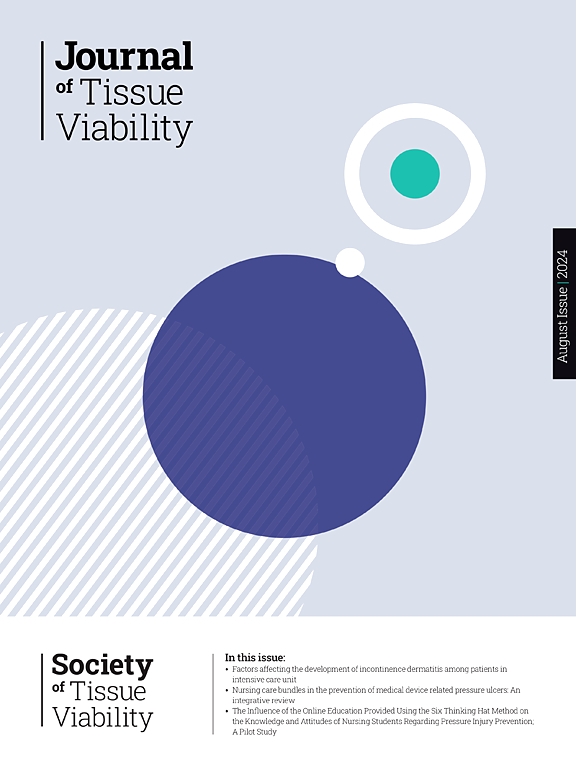Factors aggravating the stage of pressure injury in dyspneic patients
IF 2.4
3区 医学
Q2 DERMATOLOGY
引用次数: 0
Abstract
Aim
This study aimed to identify the aggravating factors of pressure injuries and provide basic data for prevention and effective nursing interventions for patients with dyspnea.
Materials and methods
This secondary analysis using electronic medical records from patients with dyspnea who developed pressure injuries after admission to the general wards of five hospitals in Korea between March 2022 and May 2022. Data were collected using a standardized case report form to gather information on clinical characteristics and pressure injuries.
Results
The mean age of the 214 patients was 71.6 ± 10.99 years. Common comorbidities included diabetes mellitus (43.4 %) and cardiovascular diseases (21.5 %). Most patients (94.4 %) required oxygen therapy. At the time of pressure injury occurrence, the Braden scale scores ≤16 was 74.3 % at pressure injury occurrence. Pressure injuries were classified as stage 1 (25.5 %), stage 2 or higher (58.4 %), and unstageable (18.1 %). The multivariate analysis revealed that fecal incontinence (odds ratio [OR]: 0.12, 95 % confidence interval [CI]: 0.04–0.42), albumin ≥3.5 g/dl (OR: 0.57, 95 % CI: 0.34–0.95) and use of restraints (OR: 3.57, 95 % CI: 1.53–8.30) were significant predictive factors for advanced stage pressure injury.
Conclusions
This study identified fecal incontinence, albumin level, the use of restrains as a significant predictive factors for advanced stage pressure injury in dyspneic patients. These highlight the need for tailored preventive strategies and monitoring, particularly for patients requiring restraints, to reduce the incidence and severity of pressure injury in this population.
加重呼吸困难患者压力损伤阶段的因素
目的探讨压力性损伤的加重因素,为呼吸困难患者的预防和有效护理干预提供基础数据。材料和方法本研究对2022年3月至2022年5月韩国五家医院普通病房住院后出现压力损伤的呼吸困难患者的电子病历进行了二次分析。使用标准化病例报告表收集数据,以收集临床特征和压力损伤的信息。结果214例患者平均年龄为71.6±10.99岁。常见的合并症包括糖尿病(43.4%)和心血管疾病(21.5%)。大多数患者(94.4%)需要氧疗。在压迫性损伤发生时,布雷登量表得分≤16分的占压迫性损伤发生时的74.3%。压伤分为1期(25.5%)、2期及以上(58.4%)和不可分期(18.1%)。多因素分析显示,尿失禁(比值比[OR]: 0.12, 95%可信区间[CI]: 0.04-0.42)、白蛋白≥3.5 g/dl (OR: 0.57, 95% CI: 0.34-0.95)和使用约束(OR: 3.57, 95% CI: 1.53-8.30)是晚期压力性损伤的显著预测因素。结论本研究确定大便失禁、白蛋白水平、约束器的使用是晚期呼吸困难患者压力损伤的重要预测因素。这些突出表明需要有针对性的预防策略和监测,特别是对需要约束的患者,以减少这一人群中压力损伤的发生率和严重程度。
本文章由计算机程序翻译,如有差异,请以英文原文为准。
求助全文
约1分钟内获得全文
求助全文
来源期刊

Journal of tissue viability
DERMATOLOGY-NURSING
CiteScore
3.80
自引率
16.00%
发文量
110
审稿时长
>12 weeks
期刊介绍:
The Journal of Tissue Viability is the official publication of the Tissue Viability Society and is a quarterly journal concerned with all aspects of the occurrence and treatment of wounds, ulcers and pressure sores including patient care, pain, nutrition, wound healing, research, prevention, mobility, social problems and management.
The Journal particularly encourages papers covering skin and skin wounds but will consider articles that discuss injury in any tissue. Articles that stress the multi-professional nature of tissue viability are especially welcome. We seek to encourage new authors as well as well-established contributors to the field - one aim of the journal is to enable all participants in tissue viability to share information with colleagues.
 求助内容:
求助内容: 应助结果提醒方式:
应助结果提醒方式:


